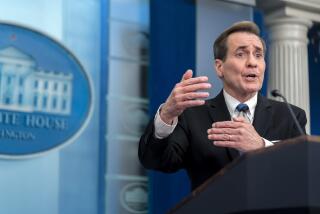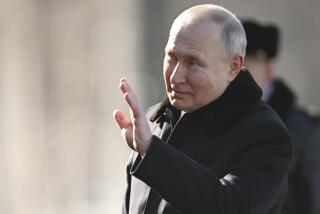Soviets May Be Softening on SDI, Shultz Says
- Share via
WASHINGTON — Secretary of State George P. Shultz said Sunday that the Soviet Union may be softening its stubborn opposition to any testing outside the laboratory of President Reagan’s space-based missile defense program, a stance blamed by the Administration for the failure of the Iceland summit.
Shultz also said the Kremlin may be relaxing its insistence on “linkage”--the all-or-nothing proposition that every East-West nuclear arms control issue now under discussion must be tied into a single package, including “Star Wars,” as the Strategic Defense Initiative is popularly called.
Appearing on NBC’s “Meet the Press,” Shultz rejected criticism that he and President Reagan had “winged it” when they proposed sweeping arms control measures to Soviet leader Mikhail S. Gorbachev without preliminary study or consultation with U.S. allies.
‘Only Way to Do It’
“It’s the only way to do it,” Shultz said, referring to Reykjavik’s nightlong sessions in which U.S. and Soviet summit delegates sought to hammer out an acceptable compromise on a Gorbachev proposal to eliminate intermediate-range nuclear weapons and cut long-range strategic arms by 50% in return for confining all space-defense testing to the laboratory.
“For years, President Reagan has been seeking radical reductions in strategic arms,” Shultz said. “He’s proposed it and proposed it and proposed it.”
At the Iceland meeting, Shultz said, Gorbachev’s idea “allowed us to consolidate ground very close to what we had been proposing for years. So we knew what we were doing. Our people in that negotiation had been over that ground a great deal. . . . And we took advantage of an opening and consolidated it.
“That’s the way you should do in a negotiation,” he continued. “You shouldn’t say ‘Gosh, it’s time for tea.’ ”
Shultz’s comments about an easing of Soviet opposition to “Star Wars” testing reinforced a flurry of reports that Moscow is reconsidering its tough stand against all testing outside the laboratory of elements of Reagan’s Strategic Defense Initiative, the formal name for his space-defense project.
America’s allies have reported that Soviet officials indicated to them that Moscow could accept testing of ground-based interceptor missiles and lasers that would form part of a “Star Wars” system, although the allies added that the Kremlin holds to its stand against testing in space.
White House Chief of Staff Donald T. Regan, who was also with Reagan in Reykjavik, said on a CBS interview program that “there have been hints to some of our negotiators” that Soviet officials would like to discuss further the problem of SDI testing.
Regan denied that the President was “inadvertently” drawn into a discussion of eliminating all nuclear weapons on both sides. Regan said Gorbachev proposed that elimination of all nuclear weapons be put on the table, adding: “And the President said, ‘Well, if that’s what you want to talk about, all right.’ But at that point they launched into a discussion of SDI and the proposals to kill it, so they never went back to that.”
Question of a ‘Snare’
Asked if Reagan was “ensnared” into a discussion of complete nuclear disarmament, a situation in which the United States would be at a disadvantage against vastly superior Soviet conventional forces, the White House chief of staff replied, “We would have at least 10 years, and probably longer than that, in which to build up our conventional weapons to at least have equality.”
Reagan, his principal aide said, “is serious, he is a man of peace, he is a man who wants to see a nuclear-free world.”
Max M. Kampelman, chief U.S. negotiator at the superpower nuclear arms control talks in Geneva, said during an ABC television interview that his Soviet counterparts proved “forthcoming” in their first post-Reykjavik meeting last week. Kampelman agreed that a change may be in the offing.
Difference in Positions
“The position taken by Mr. Gorbachev in Iceland was different from the position that I had previously understood the Soviets to hold,” he said. “It (the Iceland position) was much more restrictive.”
Gorbachev, summarizing Reykjavik in a television broadcast last Tuesday, declared that the Soviet interpretation of the 1972 Anti-Ballistic Missile Treaty ruled out all testing of “space elements” of an ABM system. He said he had asked that this strict interpretation of the treaty be applied by the United States for 10 years, during which nuclear weapons reductions would be negotiated.
Addressing the American public the night before, Reagan said that Gorbachev’s proposal “would have kept us from developing the SDI for the entire 10 years. In effect, he was killing SDI.”
‘With Empty Pockets’
Georgy A. Arbatov, a Soviet Central Committee member and authority on U.S. affairs, criticized Reagan and his staff for coming to Reykjavik “empty-handed with empty pockets,” leaving all initiatives to Gorbachev. Arbatov, appearing after Regan on CBS’s “Face the Nation,” criticized the “very slick public relations campaign with which the Administration tries to make up for very bad statesmanship at Reykjavik--it makes us concerned that the Americans are not serious.”
Nevertheless, the Soviet spokesman said, Moscow could provide “some face-saving device” to permit the United States to test elements of the SDI project, but he warned that space testing is the sticking point because, in the Soviet view of the ABM treaty, “you cannot put anything in outer space.”
Possibility for compromise, however, lies in the terms of the ABM treaty, which forbids testing or deployment of ABM systems or “components.” U.S. officials contend that some of the devices the Pentagon wants to test are too small to be considered components and that the Soviet attempt to prohibit testing of all “elements” of a system amounts to a rewriting of the 1972 pact to make it more restrictive.
Interpretation of Treaty
Viktor P. Karpov, chief Soviet negotiator at Geneva, confirmed at a news conference Friday, after resumption of the Geneva arms control talks, that interpretation of the ABM treaty was under discussion.
Shultz was asked during his Sunday television appearance about prospects that Moscow will insist that all arms control agreements come together in a single package, and he replied that “I would doubt that that idea will hold up over time.”
Shultz said that an agreement for the removal of intermediate-range missiles from Europe and their reduction in Soviet Asia to 100 or fewer could and should be reached separately.
“We’ll go forward with that,” he said. “And I believe that in the end--I hope, anyway--that we’ll be able to work that out.”
Shultz also emphasized that the Reagan Administration is not seeking just to carry out research on “Star Wars.”
Issue of Survivability
“The object of the research is to find our way to a system that will work,” he said, “and that will survive--and will have the attribute that it’s less expensive to add a piece of defense than it is (to add) a piece of offense.”
He acknowledged that a breakthrough toward a broad reduction in nuclear weapons would alter the need for SDI, estimated to have an eventual cost of $1 trillion and already encountering money problems after only two years of research. Reagan wrote to Gorbachev in July, proposing a seven-year research and testing period for SDI within the terms of the ABM treaty and a two-year period in which the two nations would try to agree on eliminating all offensive ballistic missiles.
At Reykjavik, Shultz said, Reagan combined the U.S. and Soviet positions in a “creative piece of work,” offering a 10-year commitment not to deploy SDI if negotiations for a complete dismantling of offensive nuclear weapons could begin.
“That’s what the strategic defense is defending against, so you’re getting something very important for that 10-year period,” he said. “Furthermore, since it’s pretty clear by now that the existence of a vigorous strategic defense program has been responsible for a lot of this activity, certainly we want to keep it in being--not only for deploying it as an insurance policy, but as a way of being sure that the reductions actually take place.”
More to Read
Sign up for Essential California
The most important California stories and recommendations in your inbox every morning.
You may occasionally receive promotional content from the Los Angeles Times.










